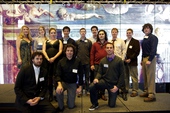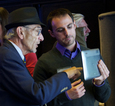Highlight
Engineering-based Approach to Analysis and Understanding of Culture Heritage Artifacts and Structures
Achievement/Results
The Palazzo Vecchio in Florence is an international field site for IGERT-TEECH. The first international expeditions took place July- December 2011, coinciding with the culmination of work on UCSD’s largest project in Florence – the search for Leonardo da Vinci’s lost masterpiece mural, “The Battle of Anghiari”. IGERT Trainees Ricky Wood, Christine Wittich, Tom Wypych, Samantha Stout, David Vanoni and Vid Petrovic all participated in multispectral and laser scanning in the Hall of the 500 in the Palazzo Vecchio, where Leonardo painted the mural that has not been seen in 450 years. The project is led by co-PI Maurizio Seracini, an advisor to several Trainees. The 2011 work culminated with a series of endoscopic surveys of the wall where Seracini discovered a brick wall on which the current fresco (by Giorgio Vasari) is painted, and a thin pocket of air behind the brick wall. Trainees Stout, Vanoni and Petrovic were part of the team that executed the final endoscopic survey in November-December 2011, but all of them used Florence and the project to further their Ph.D. work.
Trainee Christine Wittich, a Ph.D. student in structural engineering, worked with trainees from computer science and structural engineering to survey 25 Florentine statues for an assessment of their seismic fragility. Using laser scans and microscopic imaging, Wittich analyzed the statues’ current structural health in order to predict how they would react to severe earthquake tremors. The long-term goal is to figure out how to prevent or mitigate seismic damage to important statues in the earthquake-prone region of Tuscany, and in other seismic zones around the world. Preliminary results indicate that the majority of Florentine statues will rock when subject to probable earthquakes, and could possibly overturn. Wittich is now working on numerical time-history analyses and doing finite element analyses. Seismic fragility observations are expected this summer in partnership with the Getty Center, after Wittich puts two statues on a single-axis shake table at UCSD’s Englekirk Structural Engineering Center. The researcher will assess how different statue geometries – e.g., tall vs. squat – react to shaking at different speeds (‘loads’).
Trainee David Vanoni is working on an augmented reality application, Artifact, to allow interactive exploration of paintings and other artworks, and his Android tablet app was used to identify areas of the existing fresco overlapping with radar scans to help pinpoint possible areas where “The Battle of Anghiari” was most likely to be. Using available multispectral images, the app will also be useful for visualizing the data in real time on the existing fresco by artist Giorgio Vasari: you can point the tablet at the fresco, and select, for example, a thermal image, which will overlay the areas of cracks or voids and show where they are in relation to the painting. The app also has a wipe-off technology which lets the viewer look at the various spectral images (ultraviolet fluorescence, thermal, infrared, etc.) by pointing the tablet at the painting and wiping off the areas of interest with your fingers.
Fellow computer scientist and Trainee Vid Petrovic completed a detailed 3D model of the main hall where the mural is believed to be hidden. After completing LIDAR scans of the Palazzo Vecchio’s Hall of the 500, the 3D model of the space allowed Petrovic to compile videos showing fly-throughs of the hall – these were uploaded to the website of the National Geographic Society, our partner on the Anghiari project. The 3D model permits custom fly-throughs with different aspects of the scene to be explored. Click here to watch the 360-degree fly-through on the National Geographic website or click on the link for the LIDAR scan of the Salone dei Cinquecento (Hall of the 500).
Petrovic and other Trainees appeared in the National Geographic documentary, “Finding the Lost da Vinci,” which premiered in March 2012 on the National Geographic Channel. (A trailer for the documentary is available at: Finding the Lost da Vinci: The Real LIfe Da Vinci Code.)
It followed a press conference on March 12 in the Palazzo Vecchio where Florence Mayor Matteo Renzi and IGERT co-PI Maurizio Seracini announced preliminary results from the endoscopic survey in late 2011 (which was carried out in collaboration with Italy’s chief art restoration agency, the Opificio delle Pietre Dure). The endoscopic camera could only be inserted at locations where no original pigment remains in the Vasari mural, so the researchers were unable to search in parts of the wall where Dr. Seracini believes “The Battle of Anghiari” was painted. However, four lines of evidence supported the hypothesis that the lost Leonardo works is located behind the wall. One sample contained a black material which, under an electron microscope, turned out to have a chemical composition similar to a pigment in brown glazes on da Vinci’s “Mona Lisa”. The images captured with the endoscopic camera also showed a beige material that appeared to be painted with a paint brush – on the stone wall behind the brick wall where Vasari’s mural is painted today. The team also confirmed that an air pocket exists between the visible and hidden walls, lending credence to conclusions that Vasari put up the brick wall for his mural in order to safeguard the Leonardo masterpiece. Radar and other scans showed that there are no air gaps behind other existing murals in the Hall of the 500, providing additional evidence that the UCSD had pinpointed the location of “The Battle of Anghiari”. Further tests are expected to take place in 2012 and 2013, when current and future IGERT Trainees will participate in expeditions and continue to work on specific projects related to their doctoral topics.
Address Goals
IGERT Trainees participated in “The Battle of Anghiari” search and used it as the basis for broad cooperation with other Trainees and Investigators, including IGERT-TEECH PI Falko Kuester. As originally proposed, this IGERT project aimed to use international field sites and interdisciplinary teams to further discovery – by literally discovering knowledge about cultural artifacts, including paintings, statues and structures. In most of the work outlined above, IGERT Trainees were developing new technologies and methodologies that simply did not exist, or had never been used in these types of applications.
The decision to apply the interdisciplinary approach to discovering a long-lost mural by Leonardo da Vinci was fortuitous, and the preliminary results mentioned above point to evidence that the mural may still exist. However, the Florence field site and the methodology underlying the search for da Vinci’s mural involved developing a workflow that ranged from initial analysis and art-historical research to multispectral scans, computer modeling and even the refinement of tools to carry out the endoscopic survey (and to do so with minimal damage to the visible wall and mural). IGERT Trainees thus participated in the development of a framework for ‘integrative diagnostics’ – combining a broad range of sensing techniques and technologies for health assessment with multispectral imaging data, notably infrared, UV, visible light, microwave, X-ray and terahertz. The framework includes new analysis tools for surface, sub-surface and volume characterization of cultural artifacts.
This framework will be the foundation of future projects and applications to other cultural artifacts and historic structures, and IGERT Trainees will gain access to other locations to test specific tools and techniques being developed at UCSD in labs participating in IGERT-TEECH. Tools including the ARtifact Android app for tablets are also expected to find uses in other fields, in addition to potentially revolutionizing the way visitors ‘look’ at paintings and statues in museums.
The secondary NSF strategic goal served by IGERT-TEECH is Learning. The teams participating in the Florence field site and the expedition in search of da Vinci’s “The Battle of Anghiari” were provided with a rare learning experience, working alongside Italian students, scientists, curators, art conservators as well as fellow Trainees from different backgrounds and disciplines. It is noteworthy that two of the six IGERT Trainees who went to Florence for periods ranging from two to eight months were female (Samantha Stout and Christine Wittich) – a strong percentage that exceeds by far the ratio of women to men in most U.S. engineering institutions. The learning experience was also enhanced because the IGERT Trainees in Florence were at different stages of their pre-Ph.D. careers, with some in their first year of graduate school, and others nearing completion on their dissertations. Some Trainees had previous opportunities with the IGERT-TEECH PIs to work on projects related to engineering and cultural heritage, whereas others may have done previous work in other fields but were quickly absorbed into the world of cultural heritage thanks to their more senior teammates and interactions with students and faculty from the University of Florence and other partner institutions in Tuscany.
The learning goal is also served by the nature of the projects undertaken in Florence. As mentioned above, new tools for viewing art works are expected to become integrated into a new toolset for museums, in order to provide visitors with an interactive learning experience that goes beyond looking at a painting in visible light or listen to a tour guide. Augmented-reality tools such as the ARtifact will also allow students and citizens to see inside walls, or remotely explore a building from afar. The work done by IGERT Trainees in Florence is also benefiting their colleagues who worked at other IGERT-TEECH field sites in Jordan and Mongolia in 2011, and vice versa. Indeed, some Trainees who spent a summer in Florence are now slated to bring their newly-acquired expertise to enhance a cyber-archaeology project in Jordan in fall 2012.











